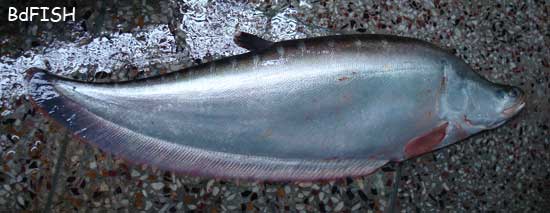
Systematic position
Phylum: ChordataClass: Actinopterygii (Ray-finned fishes)
Order: Osteoglossiformes (bonytongues)
Family: Notopteridae (featherfin knifefishes or Old World knifefishes)
Genus: Chitala
Species: C. chitala
Synonyms
Mystus chitala Hamilton, 1822
Notopterus chitala Day, 1878
Common names: Chital (Bangladesh); Humped featherback (English); Clown knifefish (Fishbase).
Distribution: Bangladesh, India, Pakistan, Myanmar and Philippines (Bhuiyan, 1964; Talwar and Jhingran, 1991).
Conservation status: Endangered in Bangladesh (IUCN Bangladesh, 2000)
Morphology: Body elongated; head and body strongly compressed laterally. Dorsal profile is highly convex. Scales are very minute and short dorsal fin. Anal fin is long and confluent with caudal fin. Pectoral fins are reduced. Dorsal portion is coppery green colored and silvery at sides and below. 15 silvery bars present on each side of dorsal ridge. 5-9 small black spots near the end of the caudal fin. Lateral line is complete. Maximum length reported 120 cm (Day, 1878). In Bangladesh, 103 cm (10 kg) was recorded from Gacher Dahar Beel of Sylhet district (Rahman, 1989).
Fin formula: D. 9; P1. 15-16; P2. 6; A. 115-120 (Rahman, 1989)
Habitat: Found in freshwater bodies such as rivers, beels, canals, reservoirs, ponds etc., particularly in large rivers (Rahman, 1989; Talwar and Jhingran, 1991). Recorded from Chalan Beel (Galib et al., 2009).
Food and feeding: Carnivorous and predator fish (Rahman, 1989). Feed on aquatic insects, mollusks, shrimps and small fishes and takes insects and tender roots of aquatic plants during its earlier stage of life (Bhuiyan, 1964).
Breeding: Breeds between June and July by building nest and eggs are 3-4.5 mm in diameter (Rahman, 1989). Eggs are 3-4.5 mm in diameter and young receive parental care (Bhuiyan, 1964).
Economics importance: Used as food fish in Bangladesh. Always this fish is marketed in fresh and sometimes in live condition. Flesh is of good flavor but full of small bones (Talwar and Jhingran, 1991).
_________________________________________________________________
REFERENCES
Bhuiyan AL. 1964. Fishes of Dacca, Asiat. Soc. Pakistan, Pub. 1, No. 13, Dacca, pp. 15-16.
Day, F. 1878. Fishes of India, being a natural history of fishes known to inhabit the seas and freshwaters of India, Burma and Ceylon. William Dawson & Sons Ltd., London, Vol. I: 778 pp.
Galib SM, Samad MA, Mohsin ABM, Flowra FA and Alam MT. 2009. Present Status of Fishes in the Chalan Beel- the Largest Beel (Wetland) of Bangladesh, Int. J. Ani. Fish. Sci. 2(3): 214-218.
Hamilton F. 1822. An account of the fishes found in the river Ganges and its branches, Archibald Constable and Company, Edinburg. 405 pp.
IUCN Bangladesh. 2000. Red Book of Threatened Fishes of Bangladesh, IUCN- The World Conservation Union, 116 pp.
Rahman AKA. 1989. Freshwater Fishes of Bangladesh, 1st edition, Zoological Society of Bangladesh, Department of Zoology, University of Dhaka, Dhaka-1000, pp. 237-238.
Talwar PK and Jhingran AG. 1991. Inland Fishes of India and Adjacent Countries, Vol. I, Oxford & IBH Publishing Co. Pvt. Ltd. New Delhi-Calcutta, pp. 63-64.
Acknowledgement: Photograph is provided by ABM Mohsin
Visited 7,411 times, 1 visits today | Have any fisheries relevant question?
